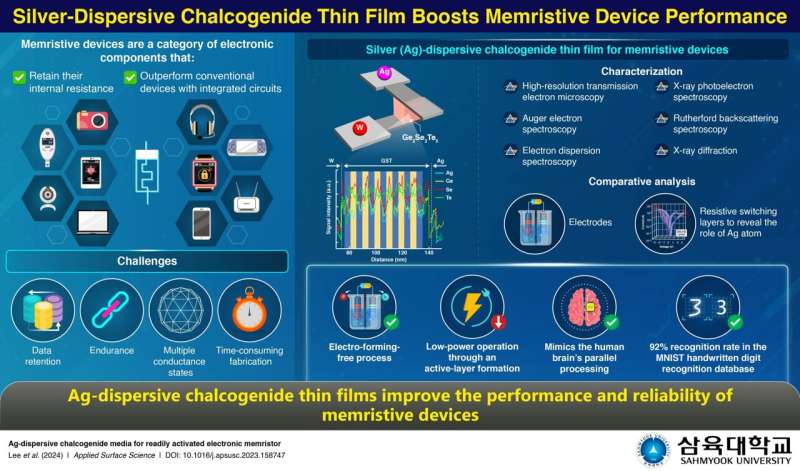This article has been reviewed according to Science X's editorial process and policies. Editors have highlighted the following attributes while ensuring the content's credibility:
fact-checked
proofread
Researchers develop thin film as resistance-switching material for next-generation memristive devices

Memristive devices are capable of retaining their internal resistance, thus offering superior performance compared to conventional devices that use integrated circuits. Several materials have been explored for the manufacture of these devices. In recent years, transition metal oxides have gradually become widely popular for this purpose.
Due to their increasing application in diverse domains like artificial intelligence systems, memristive devices must now overcome several issues related to data retention, endurance, and a large number of conductance states. Moreover, the individual fabrication of these devices is time-consuming. As a result, several challenges need to be addressed to improve their performance and reliability.
In a recent study led by Professor Min Kyu Yang from Sahmyook University, Korea, researchers have developed a silver (Ag)-dispersive chalcogenide thin film for use as a resistance-switching material in memristive devices. Their paper is published in the journal Applied Surface Science.
The proposed thin film facilitates an "electro-forming-free" process (it does not require an electric current to induce chemical change before manufacture or operation), allowing low-power operation via formation of an active layer. According to Prof. Yang, "Our diffusive Ag-based memristive device in a chalcogenide thin film shows low power consumption and mimics the human brain's parallel processing.
"his makes it suitable for implementation in crossbar arrays, and it achieved ~ 92% recognition rate in the MNIST (Modified National Institute of Standards and Technology) handwritten digit recognition database."
In this study, the researchers utilized a multitude of spectroscopic techniques to characterize the film material, including high-resolution transmission electron microscopy, X-ray photoelectron spectroscopy, Auger electron spectroscopy, and Rutherford backscattering spectroscopy. The team also analyzed various electrodes and resistive switching layers to reveal the significant role played by the Ag atom.
The device demonstrated both state retention and reliable endurance even in a challenging environment of 85°C for two hours. This study thus emphasizes the capability of chalcogenide materials to enhance the performance of memristive devices.
The present technology is expected to address the need to increase the memory capacity of semiconductors for big data applications, where the terabyte unit of storage is now considered inadequate. However, this poses the challenge of managing a large volume of chips. Consequently, the "neuromorphic chip" is being developed as the next-generation semiconductor for artificial intelligence systems. These chips need to possess characteristics like low power consumption, compact size, and the capability to analyze human behavior patterns.
"Employing the diffusive Ag-based memristive device structures could lead to the development of neuromorphic chips that could find extensive applications in the Fourth Industrial Revolution markets, including data analysis, speech recognition, facial recognition, autonomous vehicles, and the Internet of Things, as well as contributing to the ongoing 5G communication revolution," envisions Prof. Yang.
In the long term, the power consumption of these memristive devices could be suitable for applications in modeling of biological synapses in the human brain. Featuring electro-forming-free operation and low-power consumption, they are promising candidates for future nonvolatile memory and artificial synaptic devices.
More information: Su Yeon Lee et al, Ag-dispersive chalcogenide media for readily activated electronic memristor, Applied Surface Science (2023). DOI: 10.1016/j.apsusc.2023.158747




















